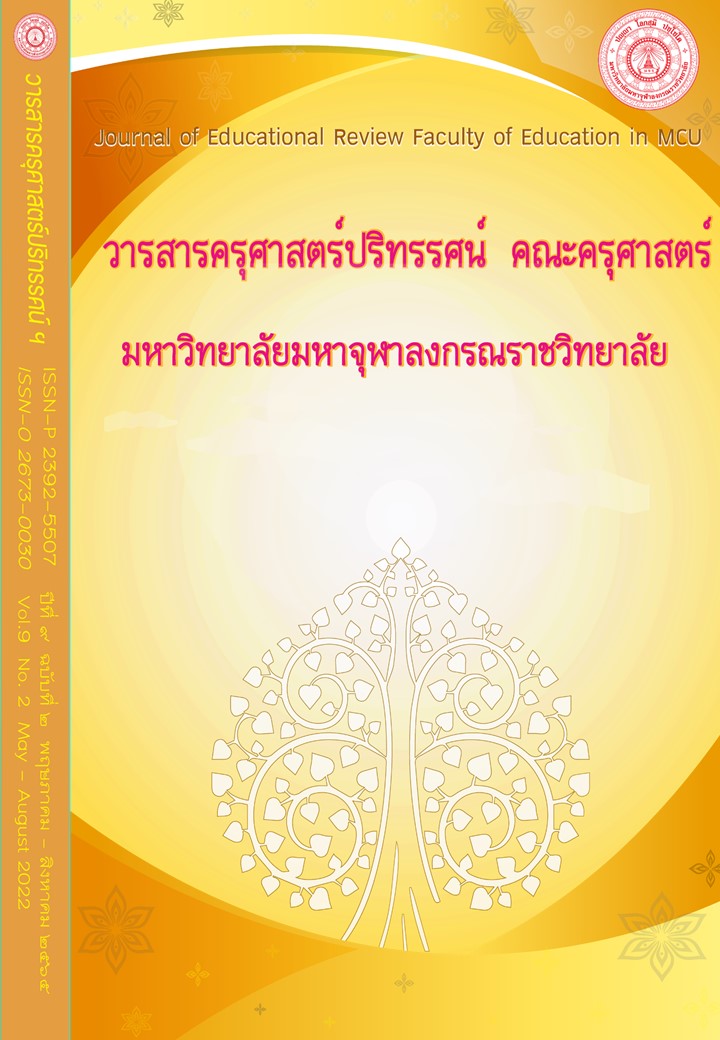MODEL OF ADMINISTRATION PAK PANANG RIVER BASIN BUDDHIST INTEGRATION
Main Article Content
Abstract
The objectives of this research paper were 1) to study the management of the Pak Phanang River Basin, 2) to study the participatory management of local network partners, and 3) to propose a model of the Pak Phanang River Basin management with an integrated Buddhist approach. This is a qualitative research by in-depth interviews with key informants, namely government agencies, community leaders representative, farmer representative, representatives of private agencies/economic promotion and tourism in the Pak Phanang River Basin area and 25 monks in total. Data were analyzed by content analysis. Results of the research were as follows: 1) the problems of the Pak Phanang River Basin were the characteristics of the Pak Phanang River Basin where the water level was lower than the sea level and the slope was low. When fresh water on the upstream side is low, saltwater can invade the Pak Phanang River in the south, flooding all year round and the soil is acidic, and sour water including sewage from shrimp farming that flows into the river until it cannot be used for cultivation and flooding problems. 2) Pak Phanang River Basin management with participation from local networks, a project to develop the Pak Phanang River Basin under the Royal Initiative has been carried out. There is support to promote the implementation of the plan with government agencies. The local community is open to the community to participate in training to educate and understand the principles of sufficiency economy, meeting to discuss and agree to open and close the floodgates appropriately. There is a system of agricultural and technological structures for management. 3) A model of the Pak Phanang River Basin management with an integrated Buddhist approach consisted of 5 components: (1) Concepts and principles of the model; Water management through participation of network partners to reduce conflicts and jointly resolve problems. Apply the principles of Sangahavatthu IV and Sappurisadhamma VII in management and Buddhist way; (2) Objectives for sustainable development promote the unity of the people distributing income to the community creating a balance for the economy, community, society as a whole; (3) the structure of the model, the process of community participation in meeting activities requires rules, regulations and the creation of common rules; (4) operational strategies, coordinating developments with the framework of the National Development Strategic Plan at the local and community level; and (5) conditions for the success of a model of participation from all sectors which there was a clear system and plan.
Article Details

This work is licensed under a Creative Commons Attribution-NonCommercial-NoDerivatives 4.0 International License.
ทัศนะและความคิดเห็นที่ปรากฏในบทความในวารสารฉบับนี้ถือเป็นความรับผิดชอบของผู้เขียนบทความนั้นเพียงผู้เดียว และไม่ถือเป็นทัศนะและความรับผิดชอบของกองบรรณาธิการ
กองบรรณาธิการขอสงวนสิทธิ์ในการคัดเลือกบทความลงตีพิมพ์และจะแจ้งให้เจ้าของบทความทราบหลังจากผู้ประเมินบทความตรวจอ่านบทความแล้ว
ต้นฉบับที่ได้รับการตีพิมพ์ในวารสารครุศาสตร์ปริทรรศน์ คณะครุศาสตร์ มหาวิทยาลัยมหาจุฬาลงกรณราชวิทยาลัย ถือเป็นกรรมสิทธิ์ของคณะครุศาสตร์ มหาวิทยาลัยมหาจุฬาลงกรณราชวิทยาลัย ห้ามนำข้อความทั้งหมดหรือบางส่วนไปพิมพ์ซ้ำ เว้นเสียแต่ว่าจะได้รับอนุญาตจากมหาวิทยาลัยฯ เป็นลายลักษณ์อักษร
References
กรมชลประทาน. (2552). โครงการพัฒนาพื้นที่ลุ่มน้ำปากพนังอันเนื่องมาจากพระราชดำริ. แหล่งที่มา https://www.rid.go.th/royalproject/index.php?option=com_content&view=article&id=137%3A2009-05-24-07-10-36&catid=66%3A2009-05-04-07-29-58&Itemid=7 สืบค้นเมื่อ 29 ธ.ค. 2564.
กระทรวงเกษตรและสหกรณ์. (2539). พระบาทสมเด็จพระเจ้าอยู่หัวกับงานด้านการจัดการทรัพยากรน้ำ. แหล่งที่มา https://www.moac.go.th/king-water สืบค้นเมื่อ 29 ธ.ค. 2564.
ณชพงศ จันจุฬา. (2557). การวิจัยแบบมีส่วนร่วมเพื่อแก้ไขปัญหาผลกระทบทางเศรษฐกิจจากการบริหารจัดการประตูระบายน้ำอุทกวิภาชประสิทธิ กรณีศึกษา : ชุมชนประมงพื้นบ้านในลุ่มน้ำปากพนัง จังหวัดนครศรีธรรมราช. รายงานการวิจัย. มหาวิทยาลัยสงขลานครินทร์ วิทยาเขตปัตตานี.
ณรงค์ บุญสวยขวัญ และคณะ. (2551). ตัวชี้วัดทางสังคม: การศึกษาสภาวะทางสังคมเศรษฐกิจเพื่อการบริหารจัดการลุ่มน้ำปากพนัง. รายงานการวิจัย. มหาวิทยาลัยวลัยลักษณ์.
นครินทร์ แก้วโชติรุ่ง. (2556). รูปแบบและหลักการของการปกครองในพระไตรปิฎก. วิทยานิพนธ์
พุทธศาสตรดุษฎีบัณฑิต. มหาวิทยาลัยมหาจุฬาลงกรณราชวิทยาลัย.
ปกรณ์ ดิษฐกิจ และคณะ. (2559). การเปลี่ยนแปลงในพื้นที่โครงการพัฒนาลุ่มน้ำปากพนังอันเนื่องมาจากพระราชดำริ จังหวัดนครศรีธรรมราช: มุมมองด้านทรัพยากรน้ำ. รายงานการวิจัย. มหาวิทยาลัยวลัยลักษณ์.
ปิ่นเพชร ภักดีณรงค์ และคณะ. (2557). การบูรณาการข้อมูลเพื่อสนับสนุนการตัดสินใจบริหารจัดการพื้นที่ลุ่มน้ำปากพนัง. รายงานการวิจัย. มหาวิทยาลัยวลัยลักษณ์.
มหาจุฬาลงกรณราชวิทยาลัย. (2539). พระไตรปิฎกภาษาไทย ฉบับมหาจุฬาลงกรณราชวิทยาลัย. กรุงเทพมหานคร: มหาจุฬาลงกรณราชวิทยาลัย.
วิทวัส พราหมณโชติ. (2556). การมีส่วนร่วมของผู้ใช้น้ำในการจัดการน้ำชลประทานของโครงการส่งน้ำและบำรุงรักษาแม่แตงอำเภอแม่แตงจังหวัดเชียงใหม่. การค้นคว้าอิสระรัฐประศาสนศาสตรมหาบัณฑิต. มหาวิทยาลัยราชภัฏเชียงราย.
WWF-ประเทศไทย. (2564). สถานการณ์น้ำจีดของโลกและประเทศไทย. แหล่งที่มา https://www.wwf.or.th/what_we_do/wetlands_and_production_landscape/freshwater/ สืบค้นเมื่อ 29 ธ.ค. 2564.


